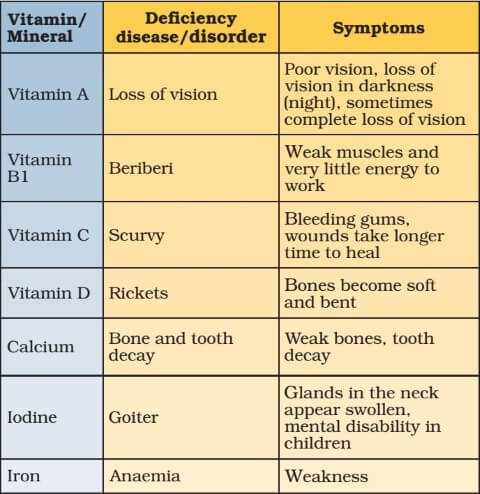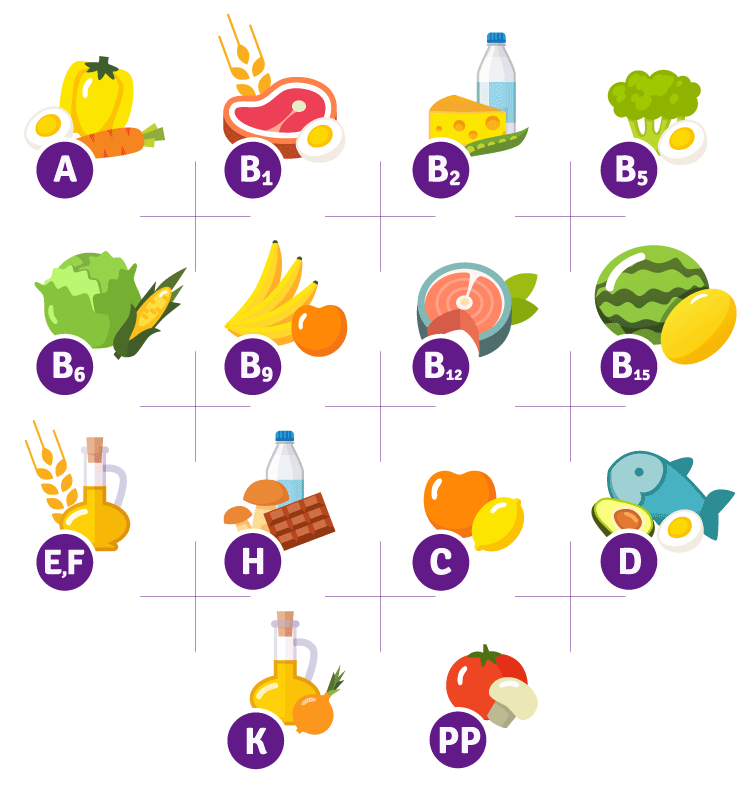Vitamins and Minerals
- Vitamins and minerals are both essential nutrients that are required in a daily diet. Altogether, there are 13 essential vitamins and many minerals which are required for the body to function properly and to maintain optimal health.
- Both vitamins and minerals combine to perform hundreds of roles in the body. Eating a healthy diet remains the best way to get sufficient amounts of the vitamins and minerals you need.
- Although they are all considered micronutrients, vitamins and minerals differ in basic ways. Vitamins are organic and can be broken down by heat, air, or acid. Minerals are inorganic and hold on to their chemical structure.
- Together this vitamin quartet helps keep your eyes, skin, lungs, gastrointestinal tract, and nervous system in good repair. Here are some of the other essential roles these vitamins play:
- Build bones – Bone formation would be impossible without vitamins A, D, and K.
- Protect vision – Vitamin A also helps keep cells healthy and protects your vision.
- Interact favorably – Without vitamin E, your body would have difficulty absorbing and storing vitamin A.
- Protect the body – Vitamin E also acts as an antioxidant (a compound that helps protect the body against damage from unstable molecules).
Vitamins
- Vitamins are organic compounds that are required in small amounts in our diet but their deficiency causes specific diseases.
- Most of the vitamins cannot be synthesized in our body but plants can synthesize almost all of them, so they are considered as essential food factors.
- However, the bacteria of the gut can produce some of the vitamins required by us.
- All the vitamins are generally available in our diet. Different vitamins belong to various chemical classes and it is difficult to define them on the basis of structure.
- They are generally regarded as organic compounds required in the diet in small amounts to perform specific biological functions for normal maintenance of optimum growth and health of the organism.
- Vitamins are designated by alphabets A, B, C, D, etc. Some of them are further named as sub-groups e.g. B1, B2, B6, B12, etc.
- Vitamin A keeps our skin and eyes healthy.
- Vitamin C helps the body to fight against many diseases. Vitamin C gets easily destroyed by heat during cooking.
- Vitamin D helps our body to use calcium for bones and teeth. It travels through your bloodstream and into cells, telling them to turn genes on or off. Almost every cell in your body has a receptor for vitamin D.
- Vitamin B12 is essential for blood formation, as well as brain and nerve function.
- Excess of vitamins is also harmful and vitamin pills should not be taken without the advice of doctor.
- The term “Vitamine” was coined from the word vital + amine since the earlier identified compounds had amino groups.
- Later work showed that most of them did not contain amino groups, so the letter ‘e’ was dropped and the term vitamin is used these days.
Vitamins are classified into two groups depending upon their solubility in water or fat.
- Fat soluble vitamins
- Vitamins that are soluble in fat and oils but insoluble in water are kept in this group. These are vitamins A, D, E, and K. They are stored in liver and adipose (fat-storing) tissues.
- Many fat-soluble vitamins travel through the body only under escort by proteins that act as carriers.
- Water soluble vitamins
- B group vitamins and vitamin C are soluble in water so they are grouped together.
- Water-soluble vitamins must be supplied regularly in the diet because they are readily excreted in urine and cannot be stored (except vitamin B12) in our body.
- They are absorbed directly into the bloodstream as food is broken down during digestion or as a supplement dissolves.
- Because much of your body consists of water, many of the water-soluble vitamins circulate easily in your body. Your kidneys continuously regulate levels of water-soluble vitamins, shunting excesses out of the body in your urine.
Deficiency Diseases
- A person may be getting enough food to eat, but sometimes the food may not contain a particular nutrient. If this continues over a long period of time, the person may suffer from its deficiency.
- Deficiency of one or more nutrients can cause diseases or disorders in our body. Diseases that occur due to lack of nutrients over a long period are called deficiency diseases.
- Vitamin A——— Night blindness
- Vitamin B1———Beriberi
- Vitamin B2——– Ariboflavinosis
- Vitamin B3 ——–Pellagra
- Vitamin B5 ——–Paresthesia
- Vitamin B6 ——–Anemia
- Vitamin B7 —— Dermatitis, enteritis
- Vitamin B9 & Vitamin B12 —– Megaloblastic anemia
- Vitamin C —— Scurvy, Swelling of Gums
- Vitamin D —— Rickets & Osteomalacia
- Vitamin E —— Less Fertility
- Vitamin K —— Non-Clotting of Blood.

Minerals
- These are inorganic nutrients that also play a key role in ensuring the health and well
- They include the trace elements copper, iodine, iron, manganese, selenium, and zinc together with the macro elements calcium, magnesium, potassium, and sodium.
- Magnesium is essential for bone and teeth structure. Low intake and blood levels of magnesium are associated with several conditions, including type 2 diabetes, metabolic syndrome, heart disease, and osteoporosis
Five Important Micronutrients
- Nutrients are the compounds in food that provide us with energy that facilitates repair and growth and helps to carry out different life processes
- As with vitamins, minerals they are found in small quantities within the body, and they are obtained from a wide variety of foods.
- No single food contains all of the vitamins and minerals we need and, therefore, a balanced and varied diet is necessary for an adequate intake.
- Of course, we already know a huge amount about how these work, and the importance they have in normal human growth and development.
- Based on this, an Expert Panel of nutritionist, NGOs, and development agencies identified five micronutrients such as those below in their priority group:
Vitamin A
- This vital micronutrient is found in a range of different foods including carrots, spinach, broccoli, milk, egg, liver and fish.
- It plays an essential role in vision (lack of Vitamin A is a common cause of blindness), reproduction and growth, and the functioning of a healthy immune system (it plays a key role in the development of white blood cells).
- Worldwide about 5 million children under the age of five are affected by xerophthalmia, a serious eye disorder caused by vitamin A deficiency.
- These children are at risk of becoming blind and are more likely to die of common childhood diseases.
Folate (folic acid)
- This is a generic term for a group of B vitamins including folic acid and naturally occurring
- Folic acid is a synthetic folate compound used in vitamin supplements and fortified food because of its increased stability.
- Folates are found in egg, dairy products, asparagus, orange juice, dark green leafy vegetables, beans and brown bread.
- They play a key role in the metabolism of amino acids and the production of proteins, the synthesis of nucleic acid (the molecules that carry genetic information in the cells), and the formation of blood cells.
Iodine
- Seaweed and fish are rich sources but in many countries the addition of iodine (known as iodization) to salt is an important source.
- Iodine is one of the most important elements required by the developing foetus due to its effect on brain development.
- Iodine also serves a number of other important functions especially in the production of hormones.
- Goitre is a visible sign of severe iodine deficiency.
Iron
- Iron has a number of key functions within the body. It acts as a carrier for oxygen from the lungs to the body’s tissues – it does so in the form of hemoglobin – and it also integral to the working of various tissues through the role that it plays in enzymatic reactions.
- Iron deficiency ultimately leads to iron deficiency anemia, the most common cause of anemia, a condition in which the blood lacks healthy red bloods cells required to carry oxygen, and which results in morbidity and death.
- Iron deficiency is the most widespread health problem in the world, impairing normal mental development in 40‐60% of infants in the developing world.
- Iron‐rich foods include lentils, red meat, poultry, fish, lentils, leaf vegetables and chick‐
Zinc
- Found in a range of foodstuffs including liver, eggs, nuts, cereals and seafood.
- The absence of zinc is associated with a number of conditions including, short stature, anemia, impaired healing of wounds, poor gonadal function, and impaired cognitive and motor function.
- It can also lead to appetite disorders, as well as contributing to the increased severity and incidence of diarrhea and pneumonia.
- The most important effect of zinc deficiency is its impact on children’s resistance to infectious diseases including the risk of infection, the recurrence of infections, and the severity of infection. This is well document in the case of diarrhoea. Zinc nutrition is therefore an important determinant of mortality in children.
Food Sources of Vitamins and Minerals

| Name | Food Sources | Deficiency Diseases |
| Vitamin A | Green leafy vegetables, ripe yellow fruits, guava, milk, liver, nuts, tomatoes, oranges, carrots, broccoli, watermelon etc. | Hyperkeratosis, night blindness, and keratomalacia |
| Vitamin B1 (Thiamine) | Fresh fruits, potatoes, sweet potatoes, peas, corn, cashew nuts, wheat, milk, black beans, dates etc. | Beriberi |
| Vitamin B2 (Riboflavin) | Banana, dates, mushrooms, grapes, mangoes, peas, pumpkin, popcorn etc. | Slow growth, sore eyes |
| Vitamin B3 (Niacin) | Meat, fish, eggs, milk products, cereals, mushroom, guava etc. | Pellagra |
| Vitamin C | Fresh fruits, black currant, broccoli, goat milk and chestnuts. | Scurvy |
| Vitamin D | Fish, egg, liver, beef, cod, chicken breast etc. | Rickets and Osteomalacia |
| Vitamin E | Potatoes, pumpkin, guava, mango, milk, nuts, seeds etc. | Heart problems, Haemolysis and sterility |
| Vitamin K | Tomatoes, broccoli, chestnuts, cashew nuts, beef, lamb, mangoes, grapes etc. | Haemorrhage |
| MINERALS | SOURCES | FUNCTIONS |
| Calcium | Blackberries, dates, milk, egg, pomegranate, almonds, wheat, soybeans etc. | Important for healthy bones, teeth and immune system |
| Sodium | Passion fruit, onions, fresh fruits, sweet potato, broccoli, pumpkin seeds, eggs, milk etc. | Helps in the regulation of blood pressure and blood volume. It also helps in the proper functioning of nerves and muscles |
| Iodine | Sea foods, iodised salt, milk and foods that are grown in iodine-rich places | Promotes healthy hair, nails, skin and teeth. Also controls body weight and growth |
| Phosphorous | Passion fruit, pomegranate, dates, beef, tuna, oats etc. | Phosphorous along with calcium is necessary for the formation of bones, teeth etc. |
Dietry Fibers
- Dietary fibres are also known as roughage. Roughage is mainly provided by plant products in our foods.
- Whole grains and pulses, potatoes, fresh fruits and vegetables are main sources of roughage.
- Roughage does not provide any nutrient to our body, but is an essential component of our food and adds to its bulk. This helps our body get rid of undigested food.

Super content
Thankyou lotus arise